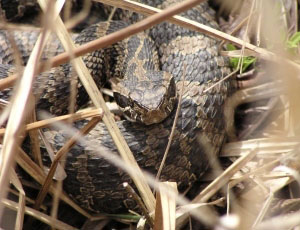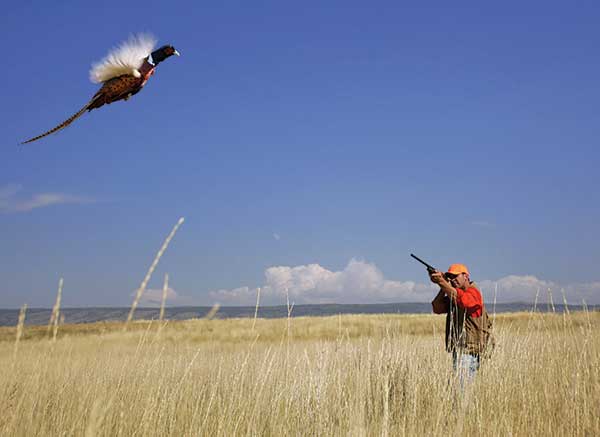- Details
(Provided by BoatUS)
Is your boat less than 26 feet? Does it have outboard motor power and rest on a trailer?
If you said yes, beware - you're a big target for theft.
A newly released study that looked at five years of BoatUS Marine Insurance claims files shows that 75 percent of all boats stolen matched this description. With the long winter lay-up period nearing, BoatUS has five tips to make your boat harder to steal.
- Details
(Provided by MDNR)
 Eastern Massasauga RattlesnakeThe U.S. Fish and Wildlife Service announced Thursday that it has listed the eastern massasauga rattlesnake as a threatened species under the federal Endangered Species Act, stating that nearly 40 percent of the snake's historical populations are now extirpated (no longer exist) and an additional 15 percent is of uncertain status.
Eastern Massasauga RattlesnakeThe U.S. Fish and Wildlife Service announced Thursday that it has listed the eastern massasauga rattlesnake as a threatened species under the federal Endangered Species Act, stating that nearly 40 percent of the snake's historical populations are now extirpated (no longer exist) and an additional 15 percent is of uncertain status.
The final rule listing the eastern massasauga appears in the Sept. 30, 2016, Federal Register and has an effective date of Oct. 31, 2016.
Under the Endangered Species Act, threatened species are considered plants and animals that may become endangered in the foreseeable future. Across the eastern massasauga rattlesnake's range, nearly 40 percent of the species' population has declined. Habitat loss is considered the primary threat driving the snakes' decline; however, as their numbers decline, other threats such as direct mortality or collection play a more significant role.
- Details
(Provided by Gamebird Assoc.)
 Study Reveals Game Bird Industry’s Economic, Social Impacts
Study Reveals Game Bird Industry’s Economic, Social Impacts
New research measuring the impact of America’s game bird farms and hunting preserves reveals that the industry contributes nearly $1.7 billion annually to the U.S. economy.
This figure, along with many others that delve deeper into the industry’s social and economic benefits, comes from the study “Economic Impact of the Gamebird Industry,” which was funded by the National Shooting Sports Foundation for the North American Gamebird Association.
The research was conducted by Southwick Associates, a leading research firm on outdoor recreation and presented by founder Rob Southwick at NAGA’s annual convention in Orlando, Florida.
While actual expenditures by game bird facilities are estimated at just over $634 million, Southwick explained that U.S. Department of Commerce models reveal these dollars actually create a $1.7 billion annual impact when the purchasing power of the recipients of the initial funds are considered. This total impact number is also known as the “multiplier effect,” and provides a better reflection of the industry’s true contribution to the economy.
- Details
Tackle manufacturers, fishing celebrities highlight Chicago Outdoor Expo
The Chicagoland Fishing, Travel & Outdoor Expo is slated for January 28-31, 2016 at the Schaumburg Convention Center in Schaumburg, Ill.
Presented by the National Marine Manufacturers Association, the Expo packs 100,000 square feet with fishing tackle manufacturers, local retailers, custom rod and tackle builders, charter boat captains, fishing guides and camps from across North America and beyond, as well as a diverse selection of the latest in fishing boats.
- Details
The Great Lakes Fishery Commission today reported that abundances of destructive, invasive sea lampreys have been knocked down to a 30 year low in Lake Huron, a 20 year low in Lake Michigan, and to below the target level in Lake Ontario.
The commission also reported that although sea lampreys are above the target levels in Lakes Erie and Superior, the trends in both lakes follow a steady five-year decline. Sea lampreys are and always will be a constant battle in the Great Lakes and without lamprey control, the fishery would suffer significant ecological and economic harm.
The sea lamprey is one of the worst human-caused ecological disasters ever inflicted upon the Great Lakes. Sea lampreys invaded through shipping canals and, by 1939, were present throughout the system. They attach to Great Lakes fish with a tooth-filled, suction cup mouth and file a hole through the fishís scales and skin with a razor-sharp tongue. The average sea lamprey will kill up to 40 pounds (18 kg) of fish during its parasitic stage. Sea lampreys prefer trout, salmon, whitefish, and sturgeon, but they also attack smaller fish like walleye and perch.
Sea lamprey control consists of several techniques including lampricides, barriers, and traps. The commission also is experimenting with sex pheromones as a way to disrupt spawning behavior. For more information about sea lampreys and control, visit www.sealamprey.org/sealamp.


